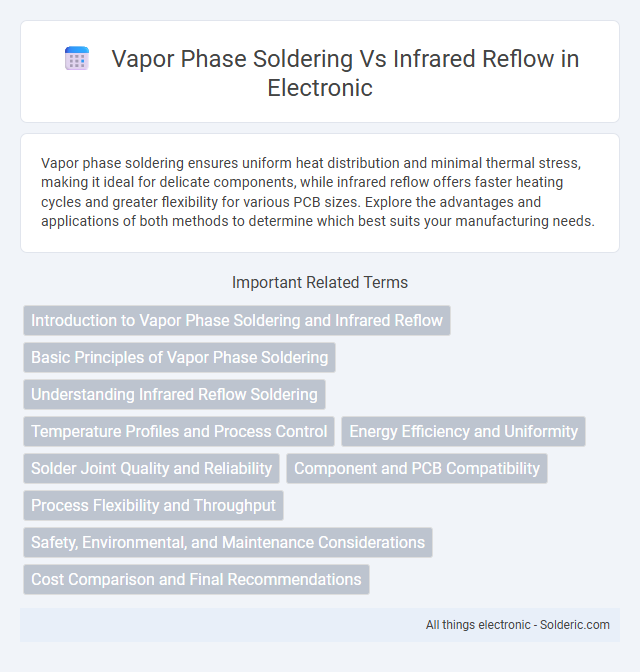Vapor phase soldering ensures uniform heat distribution and minimal thermal stress, making it ideal for delicate components, while infrared reflow offers faster heating cycles and greater flexibility for various PCB sizes. Explore the advantages and applications of both methods to determine which best suits your manufacturing needs.
Comparison Table
| Feature | Vapor Phase Soldering | Infrared Reflow |
|---|---|---|
| Heating Method | Condensation of vapor on PCB surface | Infrared radiation heating |
| Temperature Control | Precise, uniform temperature due to vapor phase | Less uniform, dependent on IR absorption |
| Thermal Stress | Low thermal shock, gentle heating | Higher thermal gradients, potential hot spots |
| Process Atmosphere | Inert vapor environment (e.g., perfluorocarbon) | Ambient air or controlled atmosphere |
| Component Suitability | Ideal for sensitive components, complex assemblies | Suitable for standard surface mount components |
| Process Speed | Moderate, longer cycle times | Faster, higher throughput |
| Equipment Cost | Higher initial and operational cost | Lower cost, widely available |
| Solder Quality | Excellent solder joint reliability | Good solder joints but risk of uneven reflow |
| Environmental Impact | Uses specialized vapors, careful disposal needed | Less environmental concern, standard ventilation |
Introduction to Vapor Phase Soldering and Infrared Reflow
Vapor phase soldering uses a heat transfer medium of saturated vapor to evenly and efficiently solder electronic components without hot spots, ensuring high-quality joints with minimal thermal stress. Infrared reflow relies on radiant heat from infrared lamps to melt solder paste, allowing quick and localized heating but sometimes causing uneven temperature distribution on complex PCB assemblies. Your choice between vapor phase and infrared reflow impacts soldering precision, thermal control, and process repeatability for electronic manufacturing.
Basic Principles of Vapor Phase Soldering
Vapor phase soldering relies on the condensation of a saturated vapor, typically perfluorinated liquids, to transfer heat uniformly to the electronic components, ensuring precise temperature control and preventing thermal damage. The process involves placing assemblies in a vapor-rich environment where the latent heat released during condensation provides consistent, efficient soldering without direct contact or exposure to harsh convection currents. This results in improved solder joint quality and reduced risk of component warping compared to infrared reflow, which uses radiative heating and can cause uneven temperature distribution.
Understanding Infrared Reflow Soldering
Infrared reflow soldering uses radiant heat to evenly melt solder paste on circuit boards, enabling precise component placement and minimizing thermal stress. This technique allows for rapid temperature ramp-up and controlled cooling, which is crucial for maintaining PCB integrity and ensuring reliable solder joints. Compared to vapor phase soldering, infrared reflow is more adaptable for complex assemblies but may require careful adjustment to avoid uneven heating.
Temperature Profiles and Process Control
Vapor phase soldering offers uniform temperature profiles by immersing components in a saturated vapor, ensuring consistent heat transfer and reducing thermal stress. Infrared reflow relies on radiant heat, which can create more variable temperature gradients across the PCB, requiring precise process control to avoid overheating or insufficient soldering. Your choice between these methods impacts the accuracy of temperature management and ultimately the quality of solder joints.
Energy Efficiency and Uniformity
Vapor phase soldering offers superior energy efficiency by utilizing a precise boiling fluid that transfers consistent heat with minimal loss, reducing overall energy consumption compared to infrared reflow systems. Infrared reflow often experiences uneven heat distribution due to the nature of radiant energy, leading to potential hotspots and inconsistent solder joints. Vapor phase soldering ensures uniform temperature across components, enhancing solder quality and reducing defects in manufacturing processes.
Solder Joint Quality and Reliability
Vapor phase soldering offers superior solder joint quality due to its uniform heat transfer and precise temperature control, minimizing thermal stress and reducing the risk of component damage. Infrared reflow can cause uneven heating, leading to potential solder joint defects such as tombstoning and incomplete wetting. Your choice of soldering method directly impacts the reliability of electronic assemblies, with vapor phase soldering often providing enhanced consistency and long-term performance.
Component and PCB Compatibility
Vapor phase soldering offers superior compatibility with sensitive components and complex PCBs due to its uniform heat distribution and precise temperature control, minimizing thermal stress. Infrared reflow can cause uneven heating and potential component damage, especially on boards with varied thermal mass or delicate materials. Your choice of soldering method directly impacts the reliability and longevity of high-density or heat-sensitive electronic assemblies.
Process Flexibility and Throughput
Vapor phase soldering offers high process flexibility with precise temperature control, making it ideal for complex or sensitive assemblies. Infrared reflow provides faster throughput suitable for high-volume production but can experience uneven heating, limiting its use for certain board designs. Vapor phase soldering is preferred when consistent thermal profiles and adaptability to various components are critical.
Safety, Environmental, and Maintenance Considerations
Vapor phase soldering offers enhanced safety due to its closed system preventing exposure to toxic fumes, contrasting with infrared reflow which may emit hazardous vapors requiring robust ventilation. Environmentally, vapor phase soldering uses perfluorinated liquids with lower emissions and less energy consumption, while infrared reflow involves higher energy usage and potential ozone generation from UV lamps. Maintenance for vapor phase soldering is simplified by fewer moving parts and minimal residue buildup, whereas infrared reflow systems demand regular cleaning of emitters and optical components to ensure consistent heat profiles.
Cost Comparison and Final Recommendations
Vapor phase soldering generally incurs higher initial equipment costs due to specialized condensable fluids but offers reduced maintenance expenses and consistent soldering quality, potentially lowering long-term operational costs compared to infrared reflow systems. Infrared reflow soldering equipment tends to have lower upfront investment but may require more frequent maintenance and calibration, increasing lifetime costs and risk of thermal inconsistencies that can affect product reliability. For high-volume and precision-demanding electronics manufacturing, vapor phase soldering is recommended for its uniform heating and process stability, while infrared reflow remains a cost-effective choice for lower-volume or less complex assemblies.
Vapor phase soldering vs infrared reflow Infographic

 solderic.com
solderic.com